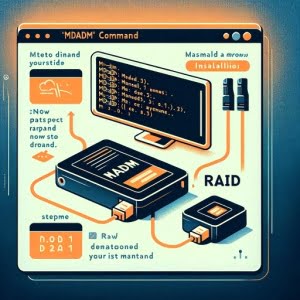Mastering RAID: How to Install Mdadm Command in Linux

Are you looking to install the mdadm command on your Linux system but aren’t sure where to start? Many Linux users, particularly beginners, might find the task intimidating. Yet, installing mdadm will make it easy to manage RAID arrays via the Linux command line. Mdadm is also readily available on most package management systems, making it a straightforward process once you know-how.
In this tutorial, we will guide you on how to install the mdadm command on your Linux system. We will show you methods for both APT and YUM-based distributions, delve into compiling mdadm from source, installing a specific version, and finally, how to use the mdadm command and ensure it’s installed correctly.
So, let’s dive in and begin installing mdadm on your Linux system!
TL;DR: How Do I Install and Use the ‘mdadm’ Command in Linux?
In most Linux distributions, ‘mdadm’ can be installed using the package manager. For example, in Ubuntu, you can run
sudo apt-get install mdadm. To create a RAID array, you can use the commandmdadm --create /dev/md0 --level=1 --raid-devices=2 /dev/sda1 /dev/sdb1.
# Install mdadm on Ubuntu
sudo apt-get install mdadm
# Create a RAID array
mdadm --create /dev/md0 --level=1 --raid-devices=2 /dev/sda1 /dev/sdb1
# Output:
# mdadm: array /dev/md0 started.
This is just a basic way to install the mdadm command in Linux and create a RAID array, but there’s much more to learn about installing and using mdadm. Continue reading for more detailed information and advanced usage scenarios.
Table of Contents
- Understanding and Installing the ‘mdadm’ Command
- Installing Mdadm from Source Code
- Installing Different Versions of Mdadm
- Using the Mdadm Command
- Verifying Mdadm Installation
- Diversifying RAID Management: Alternative Tools
- Troubleshooting Common Mdadm Issues
- Important Considerations
- RAID Technology: The Backbone of Mdadm
- The Importance of RAID Management for Data Integrity and System Performance
- Exploring Related Concepts: Filesystems and Disk Partitioning
- Further Resources for Mastering RAID Management
- Wrapping Up: Installing the ‘mdadm’ Command in Linux
Understanding and Installing the ‘mdadm’ Command
The mdadm command is a powerful utility in Linux used to manage and monitor software RAID devices. RAID, or Redundant Array of Independent Disks, is a technology that combines multiple physical disks into a single logical unit for the purposes of redundancy, performance, or both. The mdadm command allows you to create, manage, and monitor RAID arrays in a Linux environment.
Now, let’s explore how to install the mdadm command in Linux using different package managers.
Installing with APT
For Debian-based distributions like Ubuntu, you can use the APT package manager to install mdadm.
sudo apt update
sudo apt install mdadm
# Output:
# Reading package lists... Done
# Building dependency tree
# Reading state information... Done
# The following additional packages will be installed:
# libaio1 libreadline5
# Suggested packages:
# dracut-core
# The following NEW packages will be installed:
# libaio1 libreadline5 mdadm
# 0 upgraded, 3 newly installed, 0 to remove and 0 not upgraded.
# Need to get 395 kB of archives.
# After this operation, 1,082 kB of additional disk space will be used.
# Do you want to continue? [Y/n]
In the above example, we first update the package lists for upgrades and new packages using sudo apt update. Then, we install the mdadm package with sudo apt install mdadm. The terminal will then show the progress of the installation.
Installing with YUM
For Red Hat-based distributions like CentOS, you can use the YUM package manager to install mdadm.
sudo yum install mdadm
# Output:
# Loaded plugins: fastestmirror, langpacks
# Loading mirror speeds from cached hostfile
# Resolving Dependencies
# --> Running transaction check
# ---> Package mdadm.x86_64 0:4.1-5.el7 will be installed
# --> Finished Dependency Resolution
# Dependencies Resolved
#
# Total download size: 400 k
# Installed size: 1.2 M
# Is this ok [y/d/N]: y
# Downloading packages:
# Running transaction check
# Running transaction test
# Transaction test succeeded
# Running transaction
# Installing : mdadm-4.1-5.el7.x86_64
# Verifying : mdadm-4.1-5.el7.x86_64
# Installed:
# mdadm.x86_64 0:4.1-5.el7
In this example, we use sudo yum install mdadm to install the mdadm package. The terminal then shows the progress of the installation.
Installing Mdadm from Source Code
If you require a specific version of mdadm or wish to have the latest updates, you might want to consider installing from source code. Here’s how you can do it:
wget https://www.kernel.org/pub/linux/utils/raid/mdadm/mdadm-4.1.tar.xz
# Output:
# --2022-06-07 15:52:20-- https://www.kernel.org/pub/linux/utils/raid/mdadm/mdadm-4.1.tar.xz
# Resolving www.kernel.org (www.kernel.org)... 198.145.20.140, 199.233.151.196, 2604:1380:2001:d00::1
# Connecting to www.kernel.org (www.kernel.org)|198.145.20.140|:443... connected.
# HTTP request sent, awaiting response... 200 OK
# Length: 416964 (407K) [application/x-xz]
# Saving to: ‘mdadm-4.1.tar.xz’
100%[======================================>] 416,964 --.-K/s in 0.1s
# 2022-06-07 15:52:21 (3.14 MB/s) - ‘mdadm-4.1.tar.xz’ saved [416964/416964]
In the above example, we use the wget command to download the source code for mdadm version 4.1. You can replace the URL with the one corresponding to the version you want to download.
Installing Different Versions of Mdadm
From Source Code
Once you have the source code, you can compile and install it with the following commands:
# Extract the tarball
xz -d mdadm-4.1.tar.xz
# Output:
# mdadm-4.1.tar
# Compile the source code
make
# Output:
# cc -c -g -O2 -Wp,-D_FORTIFY_SOURCE=2 -fexceptions -fstack-protector-strong --param=ssp-buffer-size=4 -grecord-gcc-switches -m64 -mtune=generic -D_GNU_SOURCE -D_FILE_OFFSET_BITS=64 -D_LARGEFILE_SOURCE -DMDASSEMBLE -I../include -o mdassemble.o mdassemble.c
# Install mdadm
sudo make install
# Output:
# install -m 755 -d /usr/local/sbin
# install -m 755 mdadm /usr/local/sbin
In this example, we first extract the tarball using xz -d. Then, we compile the source code using make. Finally, we install mdadm using sudo make install.
Using Package Managers
APT
On Debian-based distributions, you can install a specific version of mdadm using the APT package manager. First, you need to look up the available versions:
apt-cache madison mdadm
# Output:
# mdadm | 4.1-5ubuntu1.2 | http://archive.ubuntu.com/ubuntu bionic-updates/main amd64 Packages
# mdadm | 4.1-5ubuntu1 | http://archive.ubuntu.com/ubuntu bionic/main amd64 Packages
In the above example, we use apt-cache madison mdadm to list the available versions of mdadm. Then, you can install a specific version using sudo apt install mdadm=.
YUM
On Red Hat-based distributions, you can install a specific version of mdadm using the YUM package manager. First, you need to look up the available versions:
yum --showduplicates list mdadm
# Output:
# Available Packages
# mdadm.x86_64 3.5-7.el7 base
# mdadm.x86_64 4.1-5.el7 updates
In the above example, we use yum --showduplicates list mdadm to list the available versions of mdadm. Then, you can install a specific version using sudo yum install mdadm-.
Version Comparison
| Version | Key Features | Compatibility |
|---|---|---|
| 4.1 | Improved support for RAID6, RAID10, and IMSM. | Compatible with all modern Linux kernels. |
| 3.5 | Basic support for RAID0, RAID1, RAID4, RAID5, and RAID6. | Compatible with Linux kernel 2.6 and later. |
Using the Mdadm Command
The mdadm command is primarily used to create, manage, and monitor RAID arrays. Here’s a basic example of how to create a RAID1 array with two devices, /dev/sda1 and /dev/sdb1:
mdadm --create /dev/md0 --level=1 --raid-devices=2 /dev/sda1 /dev/sdb1
# Output:
# mdadm: array /dev/md0 started.
In the above example, we use mdadm --create to create a new RAID array. The /dev/md0 argument specifies the name of the new array. The --level=1 argument specifies the RAID level, and the --raid-devices=2 argument specifies the number of devices in the array. Finally, /dev/sda1 and /dev/sdb1 are the devices to include in the array.
Verifying Mdadm Installation
After installing mdadm, you can check its version to ensure that it has been installed correctly:
mdadm --version
# Output:
# mdadm - v4.1 - 2018-10-01
In the above example, we use mdadm --version to display the version of the installed mdadm package. The terminal then prints the version of mdadm that is currently installed on your system.
Diversifying RAID Management: Alternative Tools
While mdadm is a powerful and widely used tool for managing RAID arrays in Linux, it’s not the only option available. There are alternative tools that you can use, each with its advantages and disadvantages. Let’s explore one such alternative: raidtools.
Raidtools: An Alternative to Mdadm
Raidtools is a set of utilities that serve the same purpose as mdadm. It is an older software package and is not as feature-rich as mdadm, but it can still be used to manage RAID arrays in Linux.
To install raidtools, you can use the following commands based on your distribution:
Installing Raidtools with APT
sudo apt update
sudo apt install raidtools2
# Output:
# Reading package lists... Done
# Building dependency tree
# Reading state information... Done
# The following NEW packages will be installed:
# raidtools2
# 0 upgraded, 1 newly installed, 0 to remove and 0 not upgraded.
# Need to get 34.8 kB of archives.
# After this operation, 102 kB of additional disk space will be used.
# Get:1 http://archive.ubuntu.com/ubuntu bionic/universe amd64 raidtools2 amd64 1.00.3-16 [34.8 kB]
# Fetched 34.8 kB in 1s (25.1 kB/s)
# Selecting previously unselected package raidtools2.
# (Reading database ... 186746 files and directories currently installed.)
# Preparing to unpack .../raidtools2_1.00.3-16_amd64.deb ...
# Unpacking raidtools2 (1.00.3-16) ...
# Setting up raidtools2 (1.00.3-16) ...
Installing Raidtools with YUM
sudo yum install raidtools
# Output:
# Loaded plugins: fastestmirror, langpacks
# Loading mirror speeds from cached hostfile
# Resolving Dependencies
# --> Running transaction check
# ---> Package raidtools.x86_64 0:1.00.3-16.el7 will be installed
# --> Finished Dependency Resolution
# Dependencies Resolved
#
# Total download size: 34 k
# Installed size: 59 k
# Is this ok [y/d/N]: y
# Downloading packages:
# Running transaction check
# Running transaction test
# Transaction test succeeded
# Running transaction
# Installing : raidtools-1.00.3-16.el7.x86_64
# Verifying : raidtools-1.00.3-16.el7.x86_64
# Installed:
# raidtools.x86_64 0:1.00.3-16.el7
Using Raidtools
Using raidtools is similar to using mdadm. Here’s an example of how to create a RAID1 array with raidtools:
mkraid /dev/md0
# Output:
# mkraid: /etc/raidtab doesn't exist or is not a regular file.
In the above example, we use mkraid to create a new RAID array. The /dev/md0 argument specifies the name of the new array. However, raidtools requires a configuration file (/etc/raidtab) to operate, which we haven’t created yet.
Raidtools vs Mdadm
While raidtools can manage RAID arrays in Linux, it’s not as user-friendly or flexible as mdadm. Here are some key differences:
raidtoolsrequires a configuration file (/etc/raidtab), whilemdadmdoes not.mdadmsupports more RAID levels thanraidtools.mdadmis more actively maintained thanraidtools.
| Tool | Configuration File | RAID Levels | Maintenance Status |
|---|---|---|---|
| raidtools | Required (/etc/raidtab) | Basic | Less active |
| mdadm | Not required | Extensive | Actively maintained |
Despite these differences, raidtools can still be a useful tool for managing RAID arrays in Linux, especially on older systems or in environments where mdadm is not available.
Troubleshooting Common Mdadm Issues
While mdadm is a powerful tool, like any other software, you may encounter issues while using it. Here are some common problems and their solutions.
Mdadm: No Arrays Found in Config File
You might encounter this error when trying to assemble a RAID array. This can happen if the array was not properly created or if the configuration file was not updated.
mdadm --assemble --scan
# Output:
# mdadm: No arrays found in config file or automatically
In the above example, the mdadm --assemble --scan command is supposed to assemble all arrays defined in the configuration file. However, it returns an error because it doesn’t find any arrays.
To fix this issue, you need to ensure that the array is properly created and that the configuration file (/etc/mdadm/mdadm.conf) is updated. You can use the mdadm --detail --scan command to generate the configuration lines for your arrays, and then add them to the configuration file.
Mdadm: Cannot Open /dev/sda: Device or Resource Busy
This error can occur when trying to add a device to a RAID array. It happens when the device is being used by another process.
mdadm --manage /dev/md0 --add /dev/sda1
# Output:
# mdadm: Cannot open /dev/sda1: Device or resource busy
In the above example, the mdadm --manage /dev/md0 --add /dev/sda1 command tries to add the /dev/sda1 device to the /dev/md0 array. However, it returns an error because the device is busy.
To fix this issue, you need to ensure that the device is not in use. You can use the lsof or fuser commands to check which process is using the device and then stop it.
Mdadm: /dev/sda1 Not Large Enough to Join Array
This error can occur when trying to add a device to a RAID array. It happens when the device is not large enough to join the array.
mdadm --manage /dev/md0 --add /dev/sda1
# Output:
# mdadm: /dev/sda1 not large enough to join array
In the above example, the mdadm --manage /dev/md0 --add /dev/sda1 command tries to add the /dev/sda1 device to the /dev/md0 array. However, it returns an error because the device is not large enough.
To fix this issue, you need to ensure that the device is large enough to join the array. You can use the fdisk command to check the size of the device.
Important Considerations
When using mdadm, keep the following points in mind:
- Always backup your data before modifying a RAID array. Mistakes can lead to data loss.
- Monitor your RAID arrays regularly. Use the
mdadm --detail /dev/mdXcommand to check the status of your arrays. - Keep your system updated. New versions of
mdadmoften include bug fixes and improvements.
RAID Technology: The Backbone of Mdadm
Before delving further into the mdadm command, it’s important to understand the technology it manages: RAID. RAID, or Redundant Array of Independent Disks, is a technology that combines multiple physical disks into a single logical unit. This can be done for various reasons, such as improving performance, ensuring data redundancy, or both.
Understanding RAID Levels
There are several RAID levels, each with its specific characteristics and use cases. Here are the most common ones:
RAID 0: Striping
RAID 0, also known as striping, splits data evenly across two or more disks with no parity information for redundancy. It’s intended to increase the system’s performance, as it allows for simultaneous read and write operations. However, it offers no data protection.
mdadm --create /dev/md0 --level=0 --raid-devices=2 /dev/sda1 /dev/sdb1
# Output:
# mdadm: array /dev/md0 started.
In the example above, we create a RAID 0 array using two devices, /dev/sda1 and /dev/sdb1. The --level=0 option specifies the RAID level.
RAID 1: Mirroring
RAID 1, also known as mirroring, duplicates the same data on two or more disks. This level provides redundancy by duplicating all data from one disk to another. If one disk fails, the data remains available on the other disks.
mdadm --create /dev/md0 --level=1 --raid-devices=2 /dev/sda1 /dev/sdb1
# Output:
# mdadm: array /dev/md0 started.
In this example, we create a RAID 1 array using two devices, /dev/sda1 and /dev/sdb1. The --level=1 option specifies the RAID level.
RAID 5: Striping with Parity
RAID 5, striping with parity, provides data striping at the byte level and also stripe error correction information. This results in excellent performance and good fault tolerance. RAID 5 is best for multi-user systems in which performance is not critical.
mdadm --create /dev/md0 --level=5 --raid-devices=3 /dev/sda1 /dev/sdb1 /dev/sdc1
# Output:
# mdadm: array /dev/md0 started.
In this example, we create a RAID 5 array using three devices, /dev/sda1, /dev/sdb1, and /dev/sdc1. The --level=5 option specifies the RAID level.
Understanding these RAID levels is crucial for using mdadm effectively, as the command allows you to manage these RAID arrays on your Linux system.
The Importance of RAID Management for Data Integrity and System Performance
RAID management, such as what you can accomplish with the mdadm command, plays a crucial role in maintaining data integrity and system performance. RAID arrays allow for redundancy, which can protect your data against hardware failures. They can also enhance system performance by distributing data across multiple disks, allowing for faster read and write operations.
For instance, a properly configured RAID 1 array can continue operating even if one disk fails, as the data is mirrored on another disk. This redundancy is crucial for maintaining data integrity.
mdadm --detail /dev/md0
# Output:
# /dev/md0:
# Version : 1.2
# Creation Time : Mon Dec 6 14:00:39 2021
# Raid Level : raid1
# Array Size : 9766304 (9.31 GiB 10.00 GB)
# Used Dev Size : 9766304 (9.31 GiB 10.00 GB)
# Raid Devices : 2
# Total Devices : 2
# Persistence : Superblock is persistent
In the above example, we use mdadm --detail /dev/md0 to check the status of the RAID 1 array named /dev/md0. The output shows that the array is functioning correctly with two devices.
Exploring Related Concepts: Filesystems and Disk Partitioning
While RAID management is a crucial aspect of system administration, it’s not the only one. Other related concepts like filesystems and disk partitioning also play significant roles in system performance and data management.
Filesystems determine how data is stored and retrieved on a disk. Different filesystems offer various features, such as journaling, snapshots, and encryption. Understanding filesystems can help you make informed decisions when configuring your RAID arrays.
Disk partitioning, on the other hand, involves dividing a disk into separate sections that can be managed independently. Each partition can have its filesystem and RAID configuration, providing flexibility in how you manage your data.
Further Resources for Mastering RAID Management
- Linux RAID Wiki: This is the official wiki for Linux RAID management. It contains in-depth information about RAID levels, configuration, and troubleshooting.
The Linux Documentation Project: Software-RAID HOWTO: This guide provides a detailed walkthrough of how to set up and manage software RAID in Linux.
IBM Knowledge Center: Linux RAID: This resource from IBM offers a comprehensive overview of RAID technology, including its history, benefits, and how it works in Linux.
Wrapping Up: Installing the ‘mdadm’ Command in Linux
In this comprehensive guide, we’ve explored the installation and use of the mdadm command in Linux, a powerful tool for managing RAID arrays. This command is crucial for maintaining data integrity and system performance in Linux environments.
We began with the basics, learning how to install mdadm using different package managers and how to create a basic RAID array. We then ventured into more advanced territory, discussing complex uses of mdadm, such as managing existing RAID arrays and recovering from failures. We also provided solutions to common issues one might encounter when using the mdadm command.
Along the way, we delved into the fundamentals of RAID technology, providing an in-depth explanation of RAID levels and their uses. We also introduced alternative tools for managing RAID arrays in Linux, such as raidtools, and highlighted their advantages and disadvantages.
Here’s a quick comparison of the methods we’ve discussed:
| Method | Pros | Cons |
|---|---|---|
| mdadm | Robust, supports many RAID levels | May require troubleshooting for some programs |
| raidtools | Supports basic RAID levels, useful on older systems | Less robust than mdadm, requires configuration file |
Whether you’re just starting out with mdadm or you’re looking to level up your RAID management skills, we hope this guide has given you a deeper understanding of mdadm and its capabilities.
The ability to manage RAID arrays effectively is a vital skill for any system administrator. With mdadm, you’re well-equipped to ensure data integrity and system performance in your Linux environment. Happy managing!


